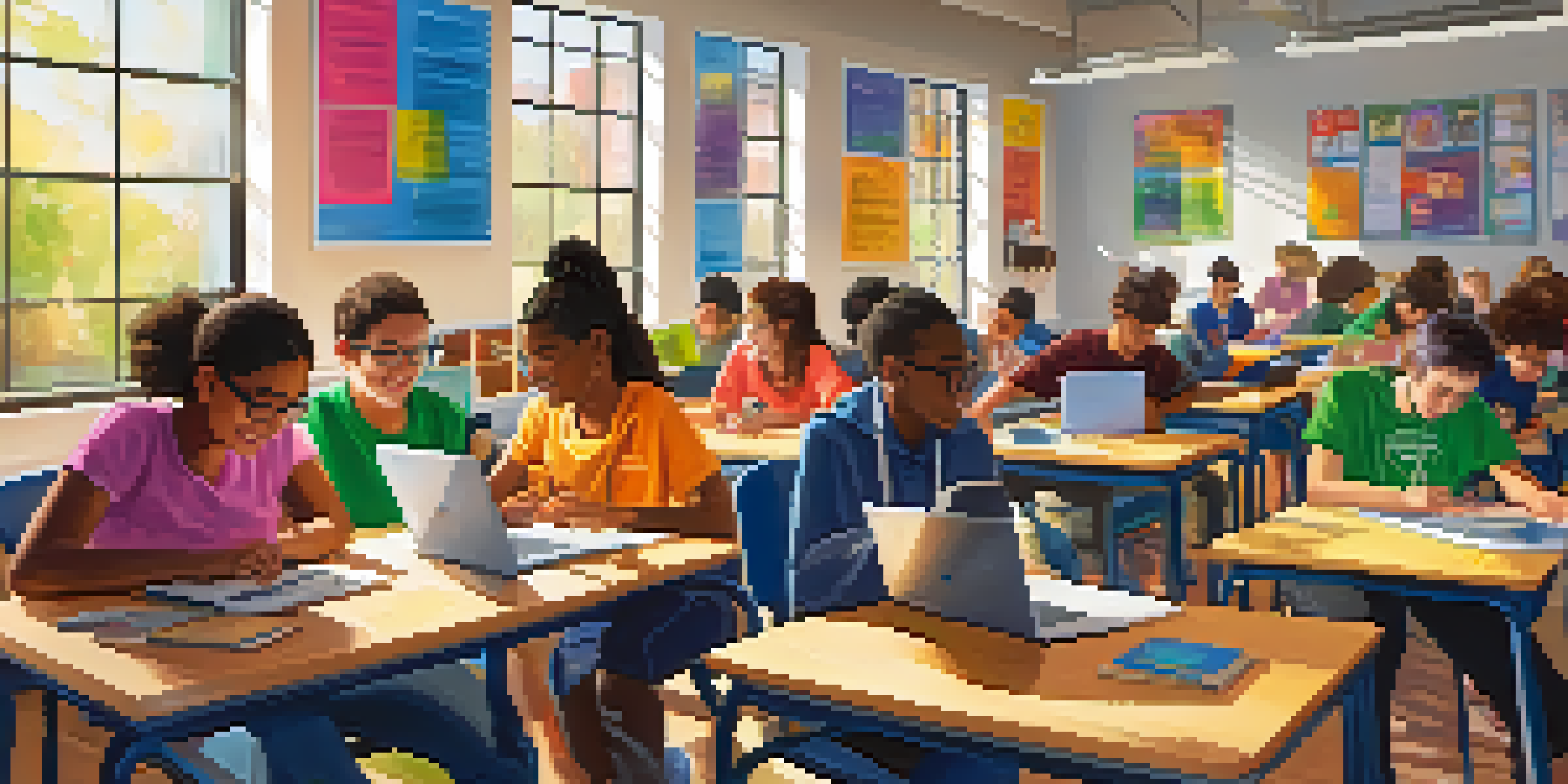Assessing Learning Outcomes Through Digital Portfolios

Understanding Digital Portfolios in Education
Digital portfolios are online collections that showcase a student's work, achievements, and reflections over time. Unlike traditional portfolios, they allow for dynamic and interactive presentations of skills and competencies. These tools not only demonstrate learning but also encourage self-reflection and goal-setting, making them invaluable in education.
Digital portfolios are a way for students to take ownership of their learning, reflecting on their progress and showcasing their unique skills.
By housing various forms of media—like essays, projects, videos, and even artwork—digital portfolios provide a holistic view of a student's abilities. They allow educators to assess not just the final product but the process behind it, offering insights into a student's development journey. Think of it as a personal website dedicated to showcasing academic and creative growth.
Furthermore, digital portfolios can be shared easily with teachers, peers, and potential employers. This accessibility helps bridge the gap between education and the professional world, allowing students to present their skills in a compelling manner. Thus, they serve as both a learning tool and a career-launching pad.
The Importance of Learning Outcomes Assessment
Learning outcomes assessment is crucial because it measures the effectiveness of educational programs. By evaluating what students have learned, educators can identify strengths and areas for improvement. This process ensures that teaching methods align with desired educational goals, ultimately leading to better student outcomes.

Incorporating digital portfolios into this assessment framework adds a rich, qualitative layer. Rather than relying solely on standardized tests, educators can capture a comprehensive picture of a student's learning journey. This approach not only highlights academic skills but also soft skills like creativity, critical thinking, and collaboration.
Digital Portfolios Enhance Learning
Digital portfolios provide a dynamic way for students to showcase their work, skills, and reflections, fostering self-assessment and growth.
Moreover, assessing learning outcomes through digital portfolios encourages active participation from students. They become co-creators of their learning narratives, which fosters a sense of ownership and motivation. This engagement is vital for cultivating lifelong learners who are invested in their education.
Benefits of Using Digital Portfolios for Assessment
One of the standout benefits of digital portfolios is their ability to provide ongoing feedback. Educators can leave comments and suggestions directly on the portfolio, allowing for real-time guidance. This feedback loop encourages students to iterate on their work, promoting a growth mindset.
The most powerful tool for learning is the learner themselves, and digital portfolios empower students to be active participants in their educational journey.
Additionally, digital portfolios foster a sense of community among learners. By sharing their work with peers, students can engage in constructive critiques and collaborative learning. This interaction not only enhances their understanding of the subject matter but also builds essential teamwork skills that are crucial in today’s workforce.
Lastly, the versatility of digital portfolios means they can be tailored to various learning styles. Whether a student excels in visual arts, writing, or technical skills, they can present their competencies in a way that feels authentic to them. This personalization makes assessments more meaningful and relevant.
Implementing Digital Portfolios in the Classroom
To effectively implement digital portfolios, educators should start by selecting the right platform. There are numerous tools available, each offering unique features tailored to different educational needs. It's essential to choose one that is user-friendly and accessible to all students, regardless of their technical skills.
Once a platform is chosen, teachers can introduce digital portfolios gradually. Starting with a simple assignment allows students to become familiar with the concept without feeling overwhelmed. As they gain confidence, educators can encourage them to expand their portfolios to include a broader range of work and reflections.
Assessment with Digital Portfolios
Incorporating digital portfolios into learning outcomes assessment allows for a comprehensive evaluation of both academic and soft skills.
Ongoing support and training for both students and teachers is crucial during this transition. Workshops or tutorials can equip everyone with the necessary skills to navigate the digital portfolio landscape. This investment in training can significantly enhance the overall effectiveness of the assessment process.
Challenges in Using Digital Portfolios
While digital portfolios offer numerous advantages, they are not without challenges. One primary concern is the digital divide; not all students have equal access to technology. Schools must address this issue to ensure that all learners can benefit from digital portfolio assessments.
Another challenge is the potential for information overload. With so many options for what to include, students might feel overwhelmed when curating their portfolios. Educators should provide clear guidelines on expectations while also allowing room for creativity and personal expression.
Lastly, there may be resistance from educators who are accustomed to traditional assessment methods. It's essential to foster an open dialogue about the benefits of digital portfolios and share success stories from peers. This can help to ease the transition and encourage more educators to embrace this innovative approach.
Evaluating Digital Portfolios for Learning Outcomes
Evaluating digital portfolios requires a thoughtful approach to ensure they effectively measure learning outcomes. Educators should establish clear rubrics that outline criteria for assessment, focusing on both content and presentation. This clarity helps students understand expectations and strive for excellence.
It's also important to incorporate self-assessment and peer assessments into the evaluation process. By reflecting on their own work and that of their classmates, students can develop critical thinking skills. This collaborative evaluation encourages a deeper understanding of the learning objectives.
Future of Digital Portfolios
The evolution of technology and AI integration promises to enhance digital portfolios, making them even more effective for personalized learning.
Finally, educators should periodically review and adjust their evaluation methods based on feedback and outcomes. This adaptive approach ensures that the assessment process remains relevant and effective, ultimately enhancing the learning experience for all students.
The Future of Digital Portfolios in Education
As technology continues to evolve, the future of digital portfolios in education looks promising. We can expect to see even more sophisticated tools that allow for greater interactivity and personalization. These advancements will empower students to take charge of their learning and showcase their skills in innovative ways.
Moreover, the integration of artificial intelligence could revolutionize how portfolios are assessed. AI-driven analytics might provide real-time insights into a student's progress, enabling educators to tailor instruction more precisely. This data-driven approach can lead to more effective teaching strategies and improved student outcomes.

Ultimately, digital portfolios represent a shift towards a more holistic and inclusive approach to education. By valuing diverse talents and learning styles, they pave the way for a future where all students can thrive. Embracing this change will not only enhance learning outcomes but also prepare students for success in a rapidly changing world.